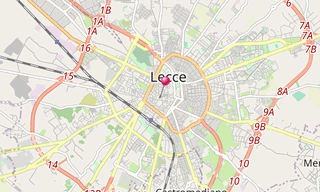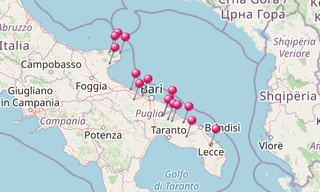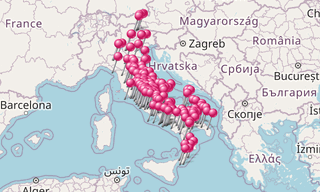Lecce is a historic city in southern Italy (on the Greek site of Messapi) and was an important centre of the Roman Empire. It is the main city of the Salentine Peninsula, a sub-peninsula at the heel of the Italian Peninsula and is over 2,000 years old. Because of the rich Baroque architectural monuments found in the city, Lecce is commonly nicknamed “The Florence of the South”. The city also has a long traditional affinity with Greek culture going back to its foundation; the Messapii who founded the city are said to have been Cretans in Greek records.
In terms of industry the “Lecce stone” (Pietra di Lecce) is the city’s main export, because it is very soft and malleable, thus suitable for sculptures. Lecce stone is a kind of limestone. Lecce is also an important agricultural centre, chiefly for its olive oil and wine production, as well as an industrial centre specialising in ceramic production.
Main sights
The Baroque style monuments of the 17th century were carved in the Pietra di Lecce and earned the city the name of Florence of the South:
Duomo di Maria Santissima Assunta., Basilica di Santa Croce (Built between 1549 and 1679)., Basilica di San Giovanni Battista al Rosario (started in 1691)., Chiesa di Sant’Irene dei Teatini., Chiesa del Gesù., Chiesa di Santa Chiara., Chiesa del Carmine., Chiesa di San Matteo., Chiesa di Sant’Angelo., Chiesa di Santa Maria degli Angeli., Chiesa di Santa Maria della Provvidenza., Chiesa di San Niccolò dei Greci., Palazzo dei Celestini., Palazzo Vescovile., Palazzo del Seminario., Porta Rudiae (18th century)., Roman Anphitheatre.

-Duomo.hero.landscape.jpg)

-Basilica-di-Santa-Croce.jpg?w=256)
-Palazzo-dei-Celestini.jpg?w=256)
.jpg?w=256)
-Duomo.jpg?w=256)
-Porta-Rudiae.jpg?w=256)
-Chiesa-di-Santa-Teresa.jpg?w=256)
-Basilica-di-Santa-Croce.jpg?w=256)
-Duomo.jpg?w=256)
-Duomo.jpg?w=256)
-Chiesa-di-San-Matteo.jpg?w=256)
-Chiesa-di-San-Giovanni-Battista.jpg?w=256)
-Basilica-di-Santa-Croce.jpg?w=256)
-Chiesa-di-San-Niccolo-dei-Greci.jpg?w=256)
.jpg?w=256)
-Basilica-di-Santa-Croce.jpg?w=256)
-Duomo.jpg?w=256)
-Duomo.jpg?w=256)
.jpg?w=256)
-Chiesa-di-Santa-Teresa.jpg?w=256)
-Basilica-di-Santa-Croce.jpg?w=256)
.jpg?w=256)
-Palazzo-del-Seminario.jpg?w=256)
-Basilica-di-Santa-Croce.jpg?w=256)
-Chiesa-del-Carmine.jpg?w=256)
-Basilica-di-Santa-Croce.jpg?w=256)
.jpg?w=256)
.jpg?w=256)
.jpg?w=256)
-Chiesa-di-Sant%E2%80%99Irene.jpg?w=256)
-Basilica-di-Santa-Croce.jpg?w=256)
-Porta-Rudiae.jpg?w=256)
-Duomo.jpg?w=256)
-Duomo.jpg?w=256)
-Chiesa-di-Sant%E2%80%99Angelo.jpg?w=256)
.jpg?w=256)
-Chiesa-del-Carmine.jpg?w=256)
.jpg?w=256)
-Chiesa-di-Sant%E2%80%99Angelo.jpg?w=256)
-Basilica-di-Santa-Croce.jpg?w=256)
-Basilica-di-Santa-Croce.jpg?w=256)
-Duomo.jpg?w=256)
-Chiesa-di-San-Giovanni-Battista.jpg?w=256)
-Duomo.jpg?w=256)
-Duomo.jpg?w=256)
-Chiesa-del-Carmine.jpg?w=256)
-Chiesa-di-Santa-Chiara.jpg?w=256)
-Chiesa-di-San-Giovanni-Battista.jpg?w=256)
-Chiesa-di-San-Matteo.jpg?w=256)
.hero.jpg?w=320)

.hero.jpg?w=320)

-Chiesa-di-Sant%E2%80%99Irene.jpg?w=256)
-Chiesa-di-Santa-Chiara.jpg?w=256)
-Chiesa-di-San-Giovanni-Battista.jpg?w=256)
-Basilica-di-Santa-Croce.jpg?w=256)
.jpg?w=256)
-Basilica-di-Santa-Croce.jpg?w=256)
-Basilica-di-Santa-Croce.jpg?w=256)
-Duomo.jpg?w=256)
.jpg?w=256)
-Basilica-di-Santa-Croce.jpg?w=256)
-Chiesa-di-Sant%E2%80%99Irene.jpg?w=256)
.jpg?w=256)
-Chiesa-di-San-Matteo.jpg?w=256)
-Basilica-di-Santa-Croce.jpg?w=256)
-Basilica-di-Santa-Croce.jpg?w=256)
-Palazzo-del-Seminario.jpg?w=256)
-Chiesa-di-Sant%E2%80%99Irene.jpg?w=256)
-Chiesa-delle-Alcantarine.jpg?w=256)
-Basilica-di-Santa-Croce.jpg?w=256)
-Palazzo-dei-Celestini.jpg?w=256)
-Chiesa-di-Santa-Chiara.jpg?w=256)
-Duomo.jpg?w=256)
-Basilica-di-Santa-Croce.jpg?w=256)
-Basilica-di-Santa-Croce.jpg?w=256)
-Basilica-di-Santa-Croce.jpg?w=256)
-Basilica-di-Santa-Croce.jpg?w=256)
-Teatro-Romano.jpg?w=256)
-Basilica-di-Santa-Croce.jpg?w=256)
-Chiesa-di-Sant%E2%80%99Irene.jpg?w=256)
-Chiesa-di-Santa-Teresa.jpg?w=256)
.jpg?w=256)
-Basilica-di-Santa-Croce.jpg?w=256)
-Chiesa-del-Carmine.jpg?w=256)
-Chiesa-di-San-Giovanni-Battista.jpg?w=256)
.jpg?w=256)
-Chiesa-di-Santa-Teresa.jpg?w=256)
-Chiesa-del-Carmine.jpg?w=256)
-Duomo.jpg?w=256)
-Basilica-di-Santa-Croce.jpg?w=256)
-Basilica-di-Santa-Croce.jpg?w=256)
-Duomo.jpg?w=256)
-Chiesa-di-San-Giovanni-Battista.jpg?w=256)
-Duomo.jpg?w=256)
-Porta-Rudiae.jpg?w=256)
-Basilica-di-Santa-Croce.jpg?w=256)
-Basilica-di-Santa-Croce.jpg?w=256)
-Chiesa-di-San-Giovanni-Battista.jpg?w=256)
.jpg?w=256)
-Chiesa-del-Carmine.jpg?w=256)
.jpg?w=256)
-Basilica-di-Santa-Croce.jpg?w=256)
.jpg?w=256)
-Chiesa-di-San-Niccolo-dei-Greci.jpg?w=256)
-Palazzo-del-Seminario.jpg?w=256)
-Chiesa-di-San-Giovanni-Battista.jpg?w=256)
.jpg?w=256)
-Duomo.jpg?w=256)
-Chiesa-di-Santa-Teresa.jpg?w=256)
-Chiesa-di-Santa-Chiara.jpg?w=256)
-Chiesa-del-Gesu.jpg?w=256)
-Duomo.jpg?w=256)
-Basilica-di-Santa-Croce.jpg?w=256)
-Duomo.jpg?w=256)
-Chiesa-di-San-Matteo.jpg?w=256)
-Chiesa-di-Santa-Teresa.jpg?w=256)
-Basilica-di-Santa-Croce.jpg?w=256)
-Basilica-di-Santa-Croce.jpg?w=256)
.jpg?w=256)
-Chiesa-di-Santa-Chiara.jpg?w=256)
-Chiesa-di-Sant%E2%80%99Irene.jpg?w=256)
-Chiesa-di-San-Matteo.jpg?w=256)
-Basilica-di-Santa-Croce.jpg?w=256)
-Chiesa-di-Santa-Chiara.jpg?w=256)
-Basilica-di-Santa-Croce.jpg?w=256)
-Basilica-di-Santa-Croce.jpg?w=256)
-Chiesa-delle-Alcantarine.jpg?w=256)
-Basilica-di-Santa-Croce.jpg?w=256)
-Basilica-di-Santa-Croce.jpg?w=256)
-Chiesa-di-Santa-Chiara.jpg?w=256)
-Chiesa-di-San-Giovanni-Battista.jpg?w=256)